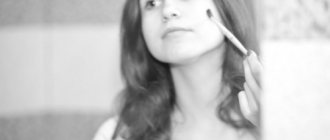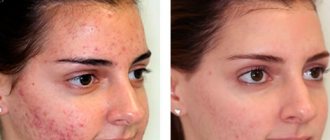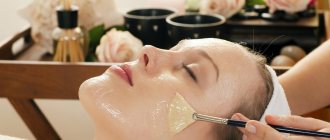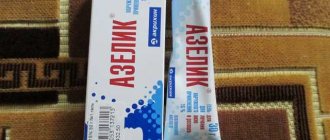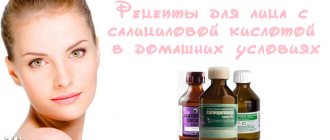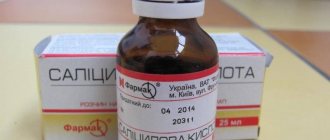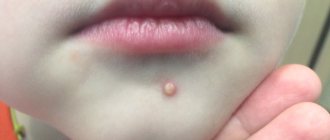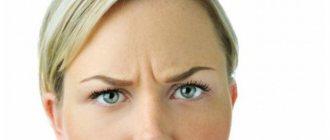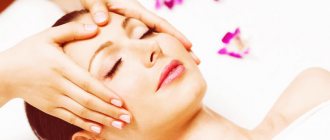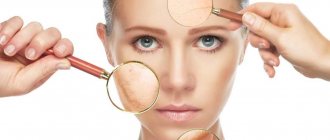Salicylic peeling is a cosmetic procedure whose action is aimed at eliminating skin defects and rejuvenating it. The technique is based on the use of a chemical substance - salicylic acid. It helps eliminate skin imperfections, acne, age spots, facial wrinkles. To carry out the procedure it is not necessary to visit a beauty salon. Salicylic peeling at home is quite possible. The main thing is to know the specifics of its implementation, the rules of skin care before and after.
…
Salicylic acid is a natural product isolated from willow bark. One of the most effective natural remedies. A powerful antiseptic is able to penetrate deeply into the pores of the exocrine glands and inhibit the production of sebum. The substance removes dead cells very well, destroys microbes and stimulates collagen production.
Benefits of salicylic acid for skin
Salicylic acid has long been considered an inexpensive and effective remedy, the main property of which is the ability to denature proteins, including microbes and bacteria. It is not dissolved with water and is not neutralized with special means.
The acid helps with skin blemishes, including:
- increased oiliness or dryness;
- acne;
- post-acne;
- enlarged pores;
- uneven complexion;
- pigmentation.
Using this type of cleansing helps exfoliate, even out complexion, absorb nutrients, etc. Another benefit is the effect on the production of new epidermal fibers.
How is it different from a salon procedure?
It is certainly more effective: in the salon they do not only superficial exfoliation, as we do, but also medium and deep exfoliation. For severe scars, spots, and profuse acne, only a high concentration of acid and an experienced cosmetologist will help. After the salon procedure, the top layer of skin is literally removed, leaving a new one. But it is also more painful and requires some post-procedure care, as there will be crusts and severe peeling.
A home procedure is a softer, gentler and safer way of exfoliation, since we do the procedure ourselves, and not under the guidance of a specialist.
There are also effective pre-made salicylic acid peels you can buy so you don't have to worry about harming your skin by using the acid yourself.
Contraindications and precautions
When performing salicylic acid peeling at home, you must take into account an important rule - only two areas of the body are treated in one session.
If you ignore this precaution, the level of substances used in the procedure in the human body will be higher than the permissible norm and the likelihood of severe intoxication increases.
The list of contraindications for such peeling includes:
- pregnancy and lactation;
- open wounds;
- tendency to hyperpigmentation;
- problems due to diabetes mellitus;
- increased dryness;
- diseases of the vascular system;
- problems with the immune system;
- high body temperature;
- inflammation or infection;
- tan received in the past 2 weeks;
- diseases in the field of dermatology.
What it is?
Salicylic peeling is a non-invasive method of corrective dermatology, which serves to impart freshness, softness to damaged, inflamed, aging skin, even out tone, and prolong youth through the use of BHA.
BHA in cosmetology means salicylic acid. The composition is vaguely similar to Acylpirin or Aspirin, due to which it has an anti-inflammatory effect.
BHAs are fat soluble, so they penetrate to a greater depth. Therefore, they are especially suitable for oily, acne-prone skin. BHA acid helps maintain cell tone in the pores and, thanks to the aforementioned anti-inflammatory effects, eliminates any skin infections.
Salicylic peeling recipes at home
Methods for performing salicylic acid peels at home depend on which area of the body needs cleansing, since the concentration of substances may vary.
The standard peeling recipe includes two main components:
- salicylic acid solution;
- aspirin tablets (powder).
The remaining ingredients are added individually.
In their classic form, all recipes can be divided into two groups:
- Superficial cleansing. It gives a small effect and has the fastest recovery time after use. The recipe includes several components. For example, peeling made from aspirin tablets, water and honey (or aloe, cream and any other substance that acts as a thickener) is popular. This mixture is thoroughly mixed and applied to the face or body for no more than 5 minutes. The layer should not be too thick. Afterwards, the substance is washed off with cool water, and the skin is lubricated with a special cream.
- Middle cleansing. Gives a stronger effect from peeling. One popular recipe consists of 4 aspirin tablets and 1 teaspoon of lemon juice. Both ingredients are mixed. The prepared peeling consistency should be applied to the face for 10 minutes. To remove the substance, dilute soda in water and wipe your face with this mixture. In this case, it serves as a neutralizer. When used, a skin reaction in the form of a slight tingling sensation is normal. However, if a strong burning sensation occurs, the solution should be washed off immediately.
The procedure protocol includes several stages
- Cleansing. Before the procedure, you must remove makeup and thoroughly cleanse the skin. To do this, you can use any cleansing agent - milk or lotion for removing makeup, gel or foam for washing. To open your pores better, you can take a steam bath after washing your face. To do this, you need to pour hot water into a small bowl, bend over it, covering your head with a towel so that the steam does not escape. The procedure time is five minutes. For greater effectiveness, you can add a pinch of dried chamomile or a few drops of essential oil to the bath.
- Degreasing. Simply washing your face before the procedure is not enough. It is also necessary to degrease the skin well so that salicylic acid can penetrate deep into the cells. For degreasing, you can use special wipes or regular tonic.
- Application of the composition. Once the skin is prepared, you can begin applying the composition. It is most convenient to apply the product using a cosmetic brush. The composition must be applied very carefully. The area around the eyes and lips should not be touched. Under no circumstances should the product come into contact with the eyes or mucous membranes. Otherwise, you may get a chemical burn.
- Withdrawal. The exposure time is approximately two minutes, then the composition must be removed. You can do this by simply washing your face with water. After the composition is removed, it is necessary to neutralize the remaining acid. To do this, you can wipe the skin with a cotton pad soaked in green tea or a weak solution of baking soda.
- Hydration. After the procedure, be sure to apply moisturizer to your face.
A couple of days after the procedure, the skin will begin to peel off. There is no need to be afraid of this, because this is how it should be. Exfoliation of the upper layer of the epidermis is a consequence of any chemical peeling.
To achieve visible results, one procedure is not enough. It is necessary to carry out a whole peeling course of 6–7 procedures. Between each procedure you should take a break of 7-10 days. Sessions should not be held too often.
Preparation for the procedure
It is important to understand that before using lactic salicylic peeling, you must carefully consider the preparatory stage.
Preparation for a chemical peel should begin several weeks before the procedure itself. Experts recommend avoiding saunas, swimming pools or gyms.
Expert opinion
Elena Apostolyuk
Cosmetologist
For washing and care, it is better to choose products that already contain a small proportion of salicylic and acidic substances. This step promotes better absorption of the peel in the future. Another important rule is avoiding ultraviolet rays.
A day before peeling, conduct a special test that will reveal the presence of allergic reactions to the substance used. To do this, apply a small amount of it to the back of the hand. If after some time no irritation, itching or other discomfort appears, then you can use such a solution for cleansing.
To achieve a good water balance in the body, you need to drink more than 2 liters of water in 24 hours.
Preparatory stage
If you have no experience using salicylic acid, you should prepare your skin before using it.
This is especially important for BHA acids, substances characterized by uneven distribution. Sometimes long (2-4 weeks) preparation is required. Before the first treatment, for 10-14 days before it, softening emulsions should be used to reduce the risk of any undesirable reaction. They are applied 1-2 times a day. It is advisable to include foods rich in protein and a sufficient amount of vitamins (especially vitamins E, C) in your diet.
Technology
The technology for performing salicylic peeling at home consists of several stages:
- Preparation. The main action at this stage is washing and cleansing with products based on fruit acids for 2 weeks before the date of peeling.
- Cleansing. Makeup should be thoroughly washed off the face and the body should be cleaned of dirt.
- Steaming. To do this, you can use a steam bath or a hot towel, which is placed on your face for 5-10 minutes.
- Peeling. Apply the prepared product to the area using gentle and smooth movements. In this case, the sensitive eye area is avoided.
- Neutralization. After 10–20 minutes (the time is determined depending on the components included in the recipe), everything is washed off with water or a solution with soda.
- Nutrition. Upon completion of peeling, cream is applied to the skin.
The salicylic peeling procedure at home is carried out in a course that consists of several sessions. The amount is determined based on the condition of the skin and the presence of defects. However, the frequency should not be more than 3 times a year.
What skin problems will the procedure help solve?
Salicylic acid has an anti-inflammatory, antiseptic and drying effect, helping to solve many aesthetic problems. To carry out procedures at a professional level, the component is included in enzyme peels for gentle skin cleansing and in complex targeted products.
A superficial chemical peeling session can be carried out independently, using a ready-made solution or gel.
Important! Do not use products with salicylic acid concentrations higher than 15%.
Salicylic peeling removes dead cells from the epidermis, giving the skin radiance and youth.
Peeling ideally copes with skin problems and has a versatile effect:
- tightens pores, cleanses them of excess sebum, providing oxygen access;
- eliminates oily shine;
- restores the functioning of the sebaceous glands;
- eliminates redness, pimples and blackheads;
- increases skin elasticity and stimulates collagen production;
- enhances the effect of creams and masks, improving the absorption of nutrients.
Healing period
The healing period after using the peeling solution is an individual indicator. It depends on factors such as:
- concentration of substances;
- recipe;
- skin condition;
- characteristics of the body.
Despite this, the standard healing period is as follows:
- 1 day. A slight redness is noticeable on the skin. There is a feeling of dryness and tightness.
- 2–4 days. The skin begins to peel off greatly, the redness subsides.
- 7–10 days. The peeling is almost gone. The skin acquires an even tone. The first results are noticeable.
At first, it is recommended to refrain from going outside, especially during the daytime. This is done to avoid exposure to external factors on the skin in the form of sun, wind, dust, etc. If it is not possible to avoid sun rays, then special creams should be used for protection.
To moisturize, use creams, milk or special masks. It is completely necessary to exclude mechanical effects of peeling and decorative cosmetics.
It is forbidden to remove the resulting crust if there is excessive peeling.
If during the recovery period the appearance of burns, wounds or other damage is noticeable, you should immediately consult a specialist.
POST-PEELING CARE
The effectiveness of the procedure depends primarily on strict adherence to the instructions and proper subsequent facial care.
1st day
The face is slightly red and may feel dry and tight. It is better not to go outside for at least a few hours to avoid unnecessary exposure to wind, sun and dust.
- It is necessary to use moisturizers (cream, milk, mask).
- You cannot use decorative cosmetics.
- UV protection SPF35+ is required.
2-4 days
Peeling begins.
- Do not use a scrub to avoid mechanical damage to the skin.
- Do not comb your face or pick off scabs.
- Cleansers without drying ingredients.
- UV protection SPF35+ is required.
First 2 weeks
- Sunbathing and visiting the solarium are prohibited (it is better to wear a wide-brimmed hat and glasses).
- Avoid sweating (for example, in the SPA or gym).
- UV protection SPF35+ is required.
If undesirable consequences occur (such as skin burns, swelling and inflammation, allergies and abnormal dehydration of the epidermis), you should immediately see a doctor . For sensitive problem skin, severely dehydrated after salicylic exfoliation, special care lines from Sothys are recommended.
User reviews
- Evgeniya, 35 years old: “A week ago I did the first procedure of a course of superficial peeling with salicylic acid. The peeling has almost disappeared and the first results are visible, which are difficult not to notice. Post-acne marks that appeared in adolescence have become less noticeable. There are still 5 procedures ahead, so I think we’ll be able to completely get rid of the problem.”
- Irina, 21 years old: “I learned about salicylic peeling from a friend, however, I decided to try it at home myself. I acted according to the recipe and followed the advice of specialists. As a result, after 3 procedures, the skin of the face was unrecognizable: it became smooth and clean. I got rid of blackheads on problem areas quickly and easily.”
Salicylic peeling at home is an effective remedy for restoring the elastic and beautiful appearance of the face, hands and other areas. This result is confirmed by a large number of patients who have undergone a course of such cleansing. However, it is important to consider that peeling can have a bad effect on the body, causing intoxication or an allergic reaction.
Rating
Bad option for IV, V, VI skin phototypes
But not everyone can benefit from the use of salicylic acids. Dermatologists recommend caution when using acid for people with 3 phototypes on the Fitzpatrick scale:
- Type IV – soft brown skin, typical Mediterranean olive shade. Rarely burns, tans well.
- Type V - dark brown skin, types of the population of the Middle East, Latin America. Rarely burns, tans easily.
- Type VI is a deep dark brown to black pigment. It never burns, the tan is almost invisible.
People with these phototypes are at risk of replacing acne with dark brown or black spots on the skin. Salicylic acid should only be used under professional supervision.
Contraindications for use
- Pregnancy and lactation period,
- Reduced immunity,
- The presence of fungal, viral or other diseases of the epidermis,
- Any surgical interventions on the facial skin performed earlier than half a year before peeling,
- Traumatic, inflammatory pigmentation and scarring of the skin (for example, keloid scars),
- Allergic reactions of the body to one of the components,
- Open, unhealed wounds
- Colds (acute respiratory infections, acute respiratory viral infections, influenza) and other causes of fever,
- Pustular diseases and acne, during exacerbation.
If unpleasant or painful sensations arise during the procedure, it must be interrupted without waiting for the end of the exposure period. Only a slight burning sensation is allowed. If you neglect this rule, you can also harm your skin.
Skin care after peeling
The duration of the rehabilitation period after peeling is different for everyone.
After salicylic peeling in the salon or at home, the face will turn red, and the top layer of skin will gradually peel off. To avoid intense peeling, use moisturizing and/or nourishing creams, lotions, toners or serums that do not contain alcohol, as this can dry out the skin even more (this applies in particular to lotions and toners).
If you had a procedure at a beauty salon, a specialist will advise you on products that will help soothe and moisturize your skin (their cost is sometimes very high).
After the procedure:
- It is recommended not to wash your face for 24 hours;
- you should avoid physical exercise, eating salty, fried, fatty foods, and alcohol;
- during the course, i.e. between peeling procedures, it is forbidden to squeeze out pimples, use scrubs, sponges;
- for 3 days you cannot use products with fruit acid, cosmetics that contain alcohol, or dye your eyebrows;
- It is forbidden to stay in the sun for a long time or visit a solarium;
- You should not go to a bathhouse or sauna during the rehabilitation period after salicylic peeling;
- It is forbidden to peel off flaky skin or speed up the skin renewal process;
- do not scratch the skin or touch it with your hands, as after peeling the skin is especially sensitive, so additional rashes may appear;
- Before going outside in sunny weather, use sunscreen.
Professional peeling preparations
On the Russian market, peeling preparations are presented in a wide range. They differ, as a rule, in the concentration of the main substance and price. For example, the drug from MediDerma (Spain) is a solution of 25% concentration, and the company Medic Control Peel produces, in addition to the main drug in a concentration of 15% and 35%, also pre-peel preparations.
The EGIA brand represents a whole line of cosmetic peeling products in Russia. These are the most skin-friendly products with a concentration of no more than 20%.
Peeling from Enerpeel is considered one of the shallow, simple and safe peels to use. From the reviews of those who have used Salipil peeling, it becomes clear that this product is inferior in quality to others, moreover, its use is very painful, and the rehabilitation period after the procedure is long.
Martinex has released a whole series of skin care products, including pre-peel, peel and post-peel treatments. The line of products from this company is suitable for any skin type.
Session duration and number of procedures
The standard course of procedures for the average woman is 10 sessions. But this figure is arbitrary, since the initial condition of the woman’s skin is taken into account: if there are several problems and the best effect needs to be achieved, the cosmetologist has the right to prescribe 2-3 courses of procedures.
On average, the entire acid peeling session, including preparing the skin and neutralizing the product applied to the face, lasts about 40 minutes. Rehabilitation after such sessions is not necessary, but proper care is needed to consolidate the results obtained from the procedure.
